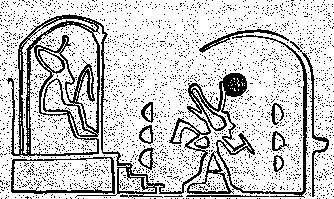4. The two sides of maitaki are often - as just has been exemplified - assymmetric. It means we should regard them as qualitatively different. There is a very old picture (ref. Campbell 2) showing how at the time of new year (the Sed Festival) the ancient Pharaohs had to visit the sanctuary of the wolf-god Upwaut, the 'Opener of the Way', and in the old picture we can recognize the same triplets of 'half-stone' signs as in maitaki:
The right (future) version of Pharaoh is in the sanctuary of Upwaut, which is located between the sets of 'half-stones'. The black ball probably represents, I think, a symbol designed after the black new moon. In ancient Egypt there were 5 'black' days between the last day in the calendar (360) and day 1 of next year. My interpretation of the picture is that the old year is represented by the 3 units formed like buns at left and the new year by those at right. A glyph in the 24th and last period of a calendar for the year in Keiti is designed very much in the same way and it evidently stands at winter solstice:
|




